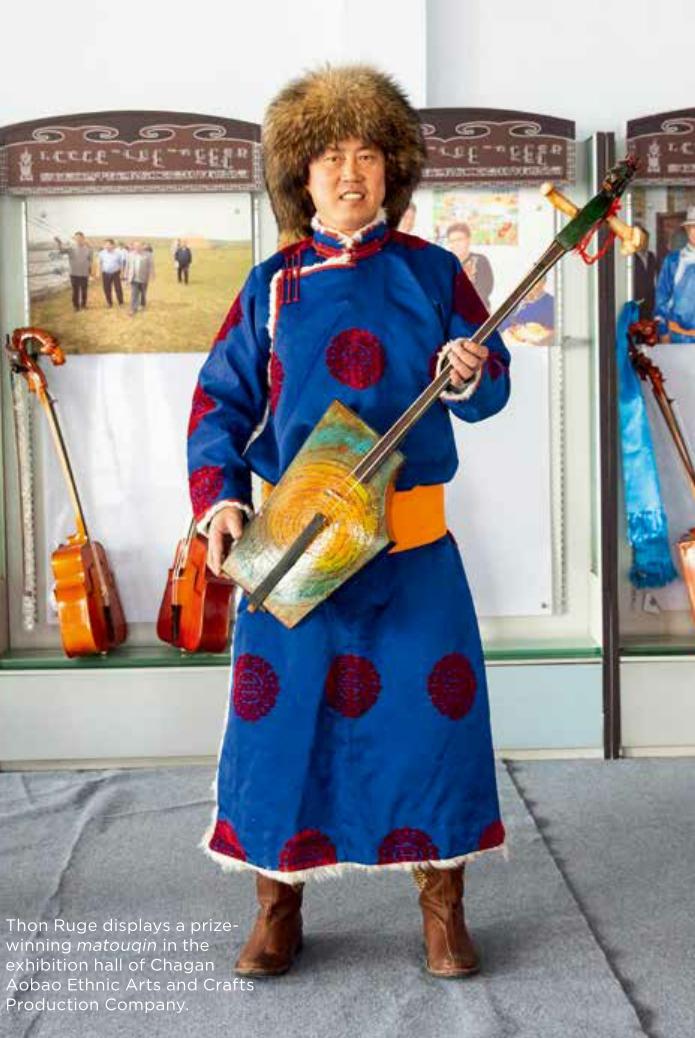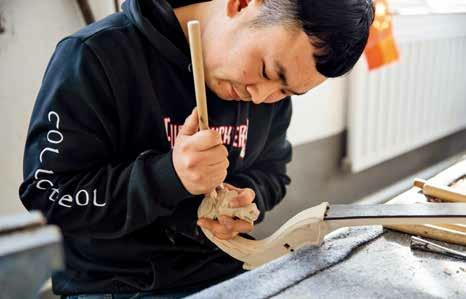Crafting Poverty Alleviation with Traditional Skills
2020-08-10byZhangJinwen
by Zhang Jinwen
Chahar Right Rear Banner(equivalent to a county) is a unique administrative division of Ulanqab City in northern Chinas Inner Mongolia Autonomous Region. This May, many of its people were busy with spring farming and agricultural production. Employees of Chagan Aobao Ethnic Arts and Crafts Production Company were right there with them.
Some workers set up yurts in front of the company. Several matouqins(a kind of bowed stringed instrument with a scroll carved like a horses head) with different styles, some Mongolian traditional furniture, and other handicraft commodities were displayed on the front desk. Technicians trimmed timber and polished furniture in the workshop.
“The company was founded out of nowhere at what happened to be the perfect time,” beamed Thon Ruge, founder and technical consultant for the company, which was established two years ago.
Rise from Poverty
Thon Ruge is a native of Chahar Right Rear Banner, where most locals were engaged in livestock husbandry and corn planting. However, he has been enthusiastic about painting since childhood. After graduating from the Fine Arts Department of Ulanqab Teachers College in 2001, he embarked on a completely different path from his ancestors.
Chahar Right Rear Banner is a cradle of Chahar culture. In recent years, the banner has continuously promoted the protection and development of Chahar culture by building a series of cultural inheritance platforms such as the Chahar Cultural Museum, the Chahar Cultural Inheritance Center, and the Ethnic Cultural Industry Park.
In 2013, the banner invested in an ethnic cultural industry street covering more than 4,000 square meters. The same year, Thon Ruge was granted a free space in the street by the local government to produce matouqin. Then, he started his own business.
“Making a good matouqin requires specific materials and high-level carving skills to complete the horse head so it captures the unique vigor and strength of Mongolian horses,” Thon Ruge noted. Because of his excellent craftsmanship, Thon Ruge gradually gained some fame over the years.
In 2018, the banner began to vigorously develop a collective economy to promote poverty alleviation. The ethnic arts and crafts collective project launched by Thon Ruge received strong support from the local Gacha (meaning“village committee” in Mongolian). That year, he officially established Chagan Aobao Ethnic Arts and Crafts Production Company.

“The local government has given us a lot of support,” Thon Ruge explained. “In the first two years, the village invested 1.3 million yuan (about US$182,000) in our company. We used this funding to purchase equipment and expand the plant, which increased our companys turnover to more than 300,000 yuan (about US$42,000). We plan to pay off the government funding in installments over three years. We have already begun dispersing a dividend of 150,000 yuan (about US$21,000) to help poverty-stricken households in the village.”
To further help eliminate poverty, the company recruits poverty-stricken villagers directly.“In the first year, we hired seven poor villagers and paid them an average annual wage of 6,500 yuan(about US$912), which realized the goal of lifting a whole family out of poverty by employing one person,” he added.
After years of efforts, Chahar Right Rear Banner has developed a mature model for promoting poverty alleviation and improving living standards through inheriting and developing ethnic culture. In recent years, the local government has actively promoted various poverty alleviation projects involving many outstanding intangible cultural heritage items including ethnic costumes, ethnic handicrafts, folk songs and dances to inject new impetus into the development of the local economy.
Protecting Traditional Culture
Thanks to their fame and experi ence after years of hard entrepreneurial work, in early 2019, Thon Ruge and two of his colleagues were respectively named the inheritors of Mongolian ethnic furniture, matouqin, and Mongolian yurt production skills by Chahar Right Rear Banner, as noted on the sixth batch of banner-level intangible cultural heritage protection projects and inheritors list.
“Our company has good sales numbers on matouqin, yurts and ethnic furniture,” he noted, with eyes on the future.“This year, we want to establish an ethnic craft training base and a cultural research base in Ulanqab, which will be completed by June. And we plan to do training and provide accommodations in yurts. In this way, students can get a more intimate experience with Mongolian culture, and we will better integrate traditional culture with modern industry.”
His plan earned support from the local government. “When the two projects were proposed, the government was very supportive and provided 200,000 yuan(about US$28,063) as a subsidy,”he said. “After the bases are completed, poverty-stricken villagers, unemployed people, and young herders can learn a skill here to help them earn more income.”
“This is also a platform for the inheritance and development of intangible cultural heritage,” he beamed. “I hope it will bring more income to villagers, and improve the living environment and cultural atmosphere of the whole village.”